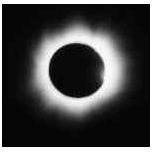How to Watch a Solar Eclipse Safely: Observing an Eclipse with Special Glasses, Filters, or Even a Sheet of Paper or Cardboard
A solar eclipse is a rare event where the Moon casts a shadow of the Sun onto the Earth. Such an eclipse can only been seen for a short period of time
because of Earth’s rotation. For many years, especially in ancient times, such events caused mixed reactions depending on the culture and traditions of the observers. For some, it means bad luck or the nearing of doomsday for all mankind. On the other hand, optimistic people see such events as miracles and could bring potential fortunes. Whatever belief you may have, an eclipse is a natural phenomenon caused by events in space.
Viewing a Solar Eclipse Safely
First and foremost, a solar eclipse involves the Sun, our nearest star. The sun is very dangerous to look at directly. The Sun emits harmful ultraviolet rays (UV) and radio waves. These elements can be transmitted within the retina of the eye which can be very damaging to your vision. Therefore, it is very important to not directly stare at a solar eclipse. This can cause an “eclipse blinding” effect, also called retina burns.
1. To let you enjoy the whole solar eclipse phenomenon, you may use special eyeglasses that are designed specifically to view an eclipse. These materials are usually coated with elements like aluminum and chromium. In numerical equivalents, the filter should be able to transmit only about 0.003% of the actual light available to the eyes.
2. Another possible device that you can use is the welding shield face mask used by construction welders called shade number 14. These masks have special glass which will allow you to observe a high intensity light source without harming your eyes. and are perfect to view a solar eclipse.
3. There are also some solar filters that are industrially manufactured. A good example would be the material which is made of aluminized polyester intentionally produced for solar observation activities. However, some researches have discovered that aluminum polyesters tend to be harmful when the coating of the material is of bad quality. So, this should be a good reminder for you in considering what devices to use.
4. One more observation device that is pretty simple and unique is to use a thin sheet of cardboard with a small hole in it. All you need to do is to let a little amount of sunlight penetrate through the hole and project it onto a white piece of paper about 3 feet beneath it. Of course, this kind of setup won’t let you to take a look at the actual events of an eclipse up in the sky as it happens. Still, you get the idea that something amazing is actually taking place by using small-scale light and shadow techniques. This is ideal for those people who have sensitive eyes and do not want to take the risk of directly observing an eclipse.
Of course, you may only be able to directly observe a solar eclipse when the moon is totally covering the sun (Not to be done in a partial or annular eclipse!). During this time, very little sunlight would reach the surface of the Earth.
There may be only a few times in our lifetimes that we will be able to observe a solar eclipse, based on the region we live in. During this rare event, it is a good idea to take the right precautions to fully enjoy the experience!
Find out when the next solar eclipse will happen and if you’ll be able to see it in your region.
References
- Image by original uploader and author was Pastorius at cs.wikipedia [GFDL (http://www.gnu.org/copyleft/fdl.html) or CC-BY-SA-3.0 (http://creativecommons.org/licenses/by-sa/3.0/)], via Wikimedia Commons
